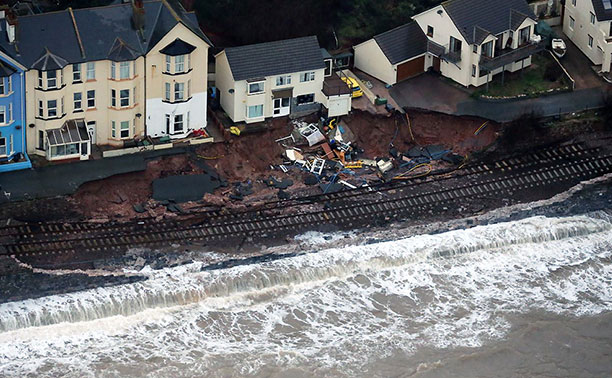
image: network rail
Climate change and transport: effects of sea-level rise on an English railway line
by Tim Willmott : Comments Off on Climate change and transport: effects of sea-level rise on an English railway line
Consequences of Climate Change
Climate change will have major consequences for transport networks, especially those located on coastlines. A study by Leeds University assessed the impact of projected sea level rise on a vulnerable stretch of railway line on the coast of South West England. The authors say their semi-empirical modelling method could provide guidance to policymakers worldwide.
Discussions of climate change and transport systems usually focus on mitigation, and how the transport sector can reduce its carbon emissions. However, adaptation is also very important. Increases in the frequency of extreme weather events will have large-scale impacts on transport networks and rail operators need to ensure they can continue to operate under future conditions.
Networks in coastal zones will be particularly threatened by sea level rise. Global sea level could rise by as much as 0.97 metres by 2100, significantly increasing the risk of coastal flooding. The potential impact of this is huge, as 65% of the world’s biggest cities (with populations >8 million) are situated on the coast, with airports, road and rail links all under threat.
Focus on SW England
This study focused on rail transport in South West England because it will experience particularly high rates of sea level rise in the near future, as it is sinking at a rate of 1.1 mm per year. The researchers used the the London to Penzance railway line at Dawlish (in Devon county) as a case study.
They were particularly interested in the 6.4 km stretch between Dawlish and Teignmouth, which has been susceptible to high seas and storms since it was built in 1846. Major line closures or blockages occur around every 10 years, with more frequent minor disruptions. A particularly severe event occurred in 2014, when winter storms overcame the sea wall in several places along the line, leaving the tracks unsupported and causing the line to be closed for two months.
In the first stage, the researchers established the relationship between sea level rise and events when water rose over the top of the sea wall (called overtopping) along the railway line, assuming sea level change to be the driver, using data from tide gauge stations which have recorded hourly changes in mean sea level in the English Channel, from 1861 to the present day. The history of overtopping was based on accounts from local and regional newspapers, libraries and rail historians and annual maintenance records. Comparing these two data sets meant clear trends could be identified.
The researchers then extrapolated the relationship to calculate the number of days with line restrictions (DLRs) from 2010 to 2100, using the UK Climate Impact Programme’s low, medium and high emissions predictions.
They looked at three types of event: Level 1 (speed restrictions), Level 2 (down line closures) and Level 3 (total line closures). Under the high emissions scenario, by 2020 the average number of DLRs will double to 16–19/year. By 2060 they estimated an average of 46–63 DLRs per year. By the end of the century, as many as 84–120 DLRs could occur each year, due to a 0.55–0.81 metre increase in sea level. This is over five times the maximum number of DLRs recorded at any point in the historical database. There would overall be an 1170% increase in the average number of DLRs by 2100 under this scenario.
The increased costs to the railway industry due to maintenance and line restrictions was estimated in the millions of pounds, while the damage caused by individual extreme events may be in the tens of millions. Even higher are the costs of diversion, which could reach billions of pounds.
Source: Dawson, D., Shaw, J. & Roland Gehrels, W. (2016). Sea-level rise impacts on transport infrastructure: The notorious case of the coastal railway line at Dawlish, England. Journal of Transport Geography, 51, pp.97–109. DOI:10.1016/j.jtrangeo.2015.
Contact: d.a.dawson@leeds.ac.uk
source: Science for Environment Policy





Comments are closed